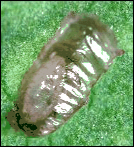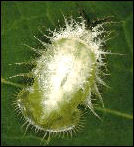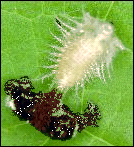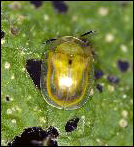- Return to Article Of The Month index
Biology of Gratiana boliviana, the First Biocontrol Agent Released to Control Tropical Soda Apple in the USA
January 2005
J.C. Medal, D. Gandolfo, and J.P. Cuda
The TSA leaf beetle, Gratiana boliviana Spaeth (Coleoptera: Chrysomelidae) was approved by the USDA-APHIS-PPQ for field release in Florida on May 7, 2003. The initial release of G. boliviana in Florida began 2003 on May 14 in Polk County. Subsequent releases were made on June 17 in Alachua County, September 5 in Hendry County, and November 11 in Sumter County. A release in the fall of 2004 has been made in DeSoto County. This beetle lay eggs individually (Figure 1) on TSA leaves and petioles. Eggs are initially white in color but turn light green during the incubation period. Each egg is enclosed by two translucent brown membranes. The egg case is attached to the leaf surface by one extreme. A female can produce on average 300 eggs. Incubation of the egg takes 5-6 days at a temperature of 25°C.

Figure 1. Gratiana boliviana egg
Larvae are cream-colored with a small green spot in the anterior half. Each segment of the body has two lateral processes and a pair of long caudal processes or small forks that arise from the last abdominal segment. Like most tortoise beetles, larvae carry the cast skins on the anal forks with the posterior end of the larva bent forward (Figure 2). The five larval instars can be completed in 15-18 days. Larval feeding is concentrated mostly in the upper third of the plant canopy. Infested plants are easily detected by clusters of small to medium size holes made by the feeding larvae. As feeding progresses, the plants may exhibit large areas of defoliated leaves. Almost complete defoliation has been observed in enclosed cages when the beetle's natural enemies are excluded.

Figure 2. Gratiana boliviana larva
The pupal stage (Figure 3) is completed in about 6-7 days. The pupae are green colored and dorsal-ventrally (from top to bottom) flattened. Pupae are attached to the leaf by the last abdominal segment. The most common pupation place is the underside of leaves. In severely defoliated plants, some pupae can be found on the petioles and stems.

Figure 3. Gratiana boliviana pupa
General coloration of the young adult is light green. Along the margin of the elytra (front wings) there is a continuous yellow band. The rest of the elytra is light green with irregular yellowish areas between rows or depressions (Figure 4). Mature adults turn a uniform yellow. Females and males can be distinguished by examining the underside of the body. In males, two somewhat rounded orange testes can be observed, one on each side of abdomen. In females there is a pair of white ovaries. Characters for separating the sexes can be observed 3-5 days after eclosion (hatching). Pre-oviposition (pre-egg laying) period takes from 9 to 12 days. Longevity of females averages 3 months.


